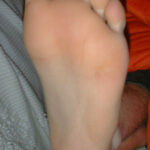Do you have twitching muscles? Does muscle twitching scare you into thinking you might have ALS or multiple sclerosis? After all, muscle twitching can be a symptom of ALS, but save the panic attack because in ALS, muscle twitching is also accompanied by muscle weakness, and unexplained lack of muscle tone (muscle atrophy). And by muscle weakness, I do not mean struggling to hoist a heavy garbage bag; or muscle weakness in that the left arm is sagging a bit while you are struggling with that grueling chest exercise or arm exercises.
ALS muscle weakness is one day, you can’t lift the hairdryer up. Or your foot gives out on you when going down the stairs and you fall. And there’s usually muscle pain in the form of muscle cramps.
Muscle twitching is a common result of strenuous muscle exercise and weight lifting exercises.
To think that twitching muscles might mean a neurological disease, is like thinking that a little gas means you have stomach cancer. Exercise is perhaps the No. 1 cause of muscle twitching. The fancy name for muscle twitching, in the absence of clinical weakness, is benign fasciculation syndrome. Fasciculation means muscle twitching.
Intense aerobic exercise has a tendency to cause muscle twitching or benign fasciculations — once the aerobic exercise is over and you have taken up a restful position, such as in front of the computer. You may find a lot of muscle twitching going on in your legs, calves and arches of your feet.
I’ve found that my twitchiest moments (legs) occur after trail running and power hiking. Heavy leg pressing has been known to make my calf muscles twitch — between sets. Heavy weight lifting exercises, as opposed to lighter weight lifting exercises, is more likely to make muscles twitch.
Bench pressing, pull-ups and intense triceps routines may trigger twitching muscles as well. Muscle twitching following strenuous exercise is perfectly normal. In fact, rather than let the twitching muscles induce fear that you have a deadly disease, remind yourself that muscle twitching means you conducted a rigorous workout — and that’s the way workouts should be: rigorous.
So what really makes muscles twitch, once you are in a resting state following the exercise?
Lactic acid is one cause. While muscles are relaxed, lactic acid, brought on by exercise, tends to pool and collect in the muscles. However, movement ceases any muscle twitching because motion “sloshes around” the lactic acid. This is why your legs may be twitching like mad as long as you are inert at your computer. But the moment you get up and walk across the room, the twitching stops. Or, it will usually stop just from moving your legs about while you remain seated.
Another cause is that the motor neurons are still “excited” or innervated from the exercise, and they need some time to calm down. Random electro-chemical impulses are firing away, causing the muscles to twitch. If anything, this means your muscles are in fine working order.




